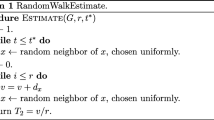Abstract
Based on the mean-field approach, epidemic spreading has been well studied. However, the mean-field approach cannot show the detailed contagion process, which is important in the control of epidemic. To fill this gap, we present a novel approach to study how the topological structure of complex network influences the concrete process of epidemic spreading. After transforming the network structure into hierarchical layers, we introduce a set of new parameters, i.e., the average fractions of degree for outgoing, ingoing, and remaining in the same layer, to describe the infection process. We find that this set of parameters are closely related to the degree distribution and the clustering coefficient but are more convenient than them in describing the process of epidemic spreading. Moreover, we find that the networks with exponential distribution have slower spreading speed than the networks with power-law degree distribution. Numerical simulations have confirmed the theoretical predictions.
Similar content being viewed by others
References
Albert R, Barabasi A L. Statistical mechanics of complex networks. Reviews of Modern Physics, 2002, 74: 47–97
Boccaletti S, Latora V, Moreno Y, et al. Complex networks: structure and dynamics. Physics Reports, 2006, 424: 175–308
Pastor-Satorras R, Vespignani A. Epidemic spreading in scale-free netwoks. Physical Review Letters, 2001, 86: 3200–3203
Joo J, Lebowitz J L. Behavior of susceptible-infected-susceptible epidemics on heterogeneous networks with saturation. Physical Review E, 2004, 69: 066105
Barthelemy M, Barrat A, Pastor-Satorras R, et al. Dynamical patterns of epidemic outbreaks in complex heterogeneous networks. Journal of Theoretical Biology, 2005, 235: 275–288
Zheng D F, Hui PM, Trimper S, et al. Epidemics and dimensionality in hierarchical networks. Physica A, 2005, 352: 659–668
Liu Z, Lai Y C, Ye N. Propagation and immunization of infection on general networks with both homogeneous and heterogeneous components. Physical Review E, 2003, 67: 031911
Ben-Naim E, Krapivsky P L. Size of outbreaks near the epidemic threshold. Physical Review E, 2004, 69: 050901
Shao Z, Sang J, Zou X, et al. Blackmail propagation on small-world networks. Physica A, 2005, 351: 662–670
Newman M E J. Spread of epidemic disease on networks. Physical Review E, 2002, 66: 016128
Zhang H, Liu Z, Ma W. Epidemic propagation and microscopic structure of complex networks. Chinese Physics Letters, 2006, 23: 1050–1053
Eguiluz V M, Klemm K. Epidemic threshold in structured scale-free networks. Physical Review Letters, 2002, 89: 108701
Liu Z, Hu B. Epidemic spreading in community networks. Europhysics Letters, 2005, 72: 315–321
Serrano M A, Boguna M. Percolation and epidemic thresholds in clustered networks. Physical Review Letters, 2006, 97: 088701
Gross T, Dommar D’Lima C J, Blasius B. Epidemic dynamics on an adaptive network. Physical Review Letters, 2006, 96: 208701
Zhou J, Liu Z. Epidemic spreading in complex networks. Frontiers of Physics in China, 2008, 3: 331–348
Zhou J, Liu Z, Li B. Influence of network structure on rumor propagation. Physics Letters A, 2007, 368: 458–463
Zhou Y, Liu Z, Zhou J. Periodic wave of epidemic spreading in community networks. Chinese Physics Letters, 2007, 24: 581–584
Zhou J, Liu Z. Epidemic spreading in communities with mobile agents. Physica A, 2009, 388: 1228–1236
Tang M, Liu L, Liu Z. Influence of dynamical condensation on epidemic spreading in scale-free networks. Physical Review E, 2009, 79: 016108
Anderson R M, May R M. Infections Diseases in Humans. Oxford University Press, Oxford, 1992
Pandit S A, Amritkar R E. Random spread on the family of smallworld networks. Physical Review E, 2001, 63: 041104
Adamic L A, Lukose R M, Puniyani A R, et al. Search in power-law networks. Physical Review E, 2001, 64: 046135
Noh J D, Rieger H. Random walks on complex networks. Physical Review Letters, 2004, 92: 118701
Parris P E, Kenkre V M. Traversal times for random walks on smallworld networks. Physical Review E, 2005, 72: 056119
Watts D J. SmallWorlds: the Dynamics of Networks Between Order and Randomness. Princeton University Press, Princeton, 1999
Yan G, Zhou T, Hu B, et al. Efficient routing on complex networks. Physical Review E, 2006, 73: 046108
Wang X G, Lai Y C, Lai C H. Oscillations of complex networks. Physical Review E, 2006, 74: 066104
Liu Z, Ma W, Zhang H, et al. An efficient approach of controlling traffic congestion in scale-free networks. Physica A, 2006, 370: 843–853
Zhang H, Liu Z, Tang M, et al. An adaptive routing strategy for packet delivery in complex networks. Physics Letters A, 2007, 364: 177–182
Watts D J, Strogatz S H. Collective dynamics of ’small-world’ networks. Nature, 1998, 393: 440
Holme P, Kim B J. Growing scale-free networks with tunable clustering. Physical Review E, 2002, 65: 026107
Wu X, Liu Z. How community structure influences epidemic spread in social networks. Physica A, 2008, 387: 623–630
Newman M E J. Assortative mixing in networks. Physical Review Letters, 2002, 89: 208701
Catanzaro M, Boguna M, Pastor-Satorras R. Generation of uncorrelated random scale-free networks. Physical Review E, 2005, 71: 027103
Tang M, Liu Z, Zhou J. Condensation in a zero range process on weighted scale-free networks. Physical Review E, 2006, 74: 036101
Newman M E J. Clustering and preferential attachment in growing networks. Physical Review E, 2001, 64: 025102
Author information
Authors and Affiliations
Corresponding author
Rights and permissions
About this article
Cite this article
Liu, Z., Wu, X. & Hui, PM. An alternative approach to characterize the topology of complex networks and its application in epidemic spreading. Front. Comput. Sci. China 3, 324–334 (2009). https://doi.org/10.1007/s11704-009-0058-7
Received:
Accepted:
Published:
Issue Date:
DOI: https://doi.org/10.1007/s11704-009-0058-7




